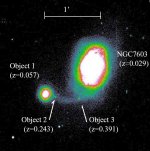The argument is based on redshift, the cause of which is what is being questioned here.
The fact remains that redshift exists, and measurements of it show structure on a universal scale.
If redshift is a measure of distance, which I don't believe it is,
Here's the thing, I don't believe it is either. Your past arguments on the topic have convinced me that it is not.
I've always considered redshift (and blueshift, for that matter) to be caused by motion, not by distance, specifically motion towards or away from an observer, which fits, considering scripture plainly telling us that God stretched out the heavens, which is a matter of motion, or more accurately, velocity, in the direction of "away" from earth. This even fits with the idea proposed on https:/kgov.com/stretch that "God pulled the light from the stars," in that He did so while moving the stars away from the earth.
of if there was evidence that the universe has finite edges then I'd agree that there is some point that could be meaningfully called the center. That are, however, pretty big IFs.
I think the problem I'm seeing is that what you've said so far is based on a lack of evidence, rather than positive evidence for either side.
To be sure, the universe either has or does not have a center and edges (or at least, a boundary where "matter is present in this location" ends and sheer vacuum (where no matter is present) begins). There's no in between.
But so far, you've simply asserted that there is no center because there is no evidence for it, but this is an argument from silence, a logical fallacy, which I will address in responding to your reply to Stripe below:
What is infinity divided by two?
Upon what basis do you assert that the universe is infinite?
It almost seems like you're begging the question...
Again, there is no evidence that the universe has a center.
Saying it doesn't make it so, though. Hence my above question.
We are as much at the center of the universe as is anything else is so far as it make sense to speak about the center of the universe.
This is begging the question that there is no center.
Also, even if the universe has a center, the mass of the universe would not necessarily have its greatest effect at that point. In fact, no amount of mass has any appreciable gravitational effect past several billion miles. Even black holes, assuming that they actually exist, affect only a small region around the center of their galaxy and the entire mass of the Andromeda Galaxy has far less gravitational effect on you that do the walls in the room you're sitting in.
But the fact remains that it does, in fact, have an effect, even if it is infinitesimally (man, that's a word I haven't typed in a while, lol) small.
True and, if so, all bets are off on ever figuring out how far away anything is past a few hundred light years distance where parallax measurements are possible.
Something else I want to point out regarding center of mass that should help us in determining if there is a center that seems to have been forgotten...
The so-called "Axis of Evil" indicates a north and south pole for the universe.

kgov.com
I would argue that if the universe were infinite, then there would be no indication whatsoever that it has an axis, which is, per the Cambridge dictionary, "a real or imaginary straight line going through the center of an object that is spinning, or a line that divides a symmetrical shape into two equal halves."
1. a real or imaginary straight line going through the centre of an object that…

dictionary.cambridge.org


